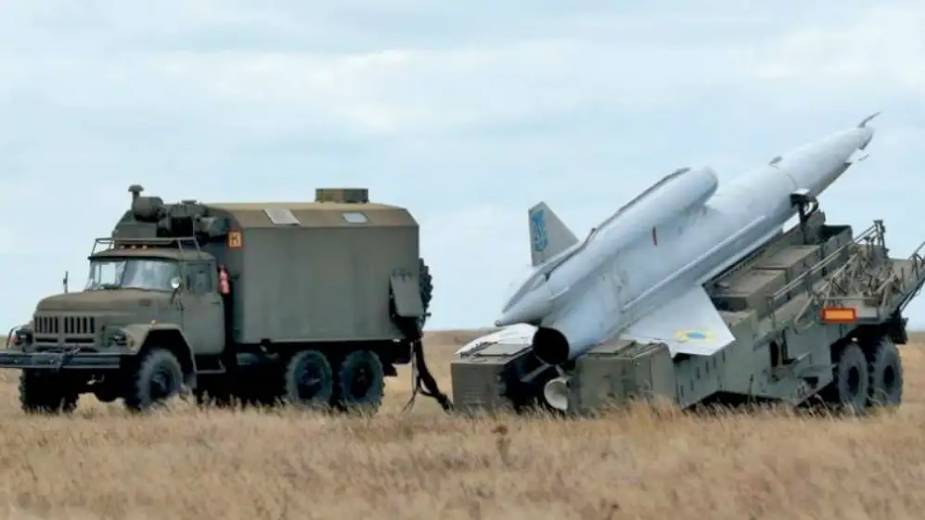Breaking news
Ukraine carries out work to transform Soviet-era Tu-141 drones into strike ones.
MOSCOW, March 30. /TASS-DEFENSE/. The program of Ukraine’s Defense Ministry to maintain the working capacity of the Soviet-era VR-2 operational/tactical systems with Tu-141 Strizh unmanned aerial vehicles (UAVs) included their transformation from reconnaissance to strike ones. This was proved by the crash of a Ukrainian Strizh drone with a combat payload in the suburbs of the Croatian capital of Zagreb, military expert Vladimir Karnozov writes in the Independent Military Review.
Follow Air Recognition on Google News at this link
 The program of Ukraine’s Defense Ministry to maintain the working capacity of the Soviet-era VR-2 operational/tactical systems with Tu-141 Strizh unmanned aerial vehicles (UAVs) included their transformation from reconnaissance to strike ones. (Picture source: Ukraine MoD)
The program of Ukraine’s Defense Ministry to maintain the working capacity of the Soviet-era VR-2 operational/tactical systems with Tu-141 Strizh unmanned aerial vehicles (UAVs) included their transformation from reconnaissance to strike ones. (Picture source: Ukraine MoD)
According to him, the Ukrainian Defense Ministry initiated a program in 2014 to improve the efficiency of the VR-2 systems, which envisaged maintaining the Strizh UAVs in good working order and improving their performance characteristics.
Tu-141 Strizh upgrade
Having analyzed the route of the Tu-141 that crashed in Croatia, experts calculated that the UAV had passed in the air for a little more than an hour, flying at a speed of 700 km/h and at an altitude of 1,300 m, and covered 1,024 km.
As Karnozov explains, the modernized drone had the same range as the original one because during the upgrade its maximum flight speed had been reduced from 1,000 km/h to 700 km/h, which had cut its fuel consumption per hour. At the same time, the expert notes that the flight altitude, which equaled 6,000 m, was also reduced.
“The inherent flight parameters were most likely changed because of the need to ensure higher survivability of the UAV over the battlefield. At an altitude of 6 km, an aerial vehicle with a length of 14 m and a wingspan of 4 m and an airframe made of aluminum alloys is perfectly observable by radars. The decrease in the altitude to 1,300 m and the speed to 700 km/h looks like a compromise between UAV observability and range,” the expert believes.
The Tu-141 UAV can carry up to 250 kg of payload, however, as the newspaper notes, the replacement of Soviet-made reconnaissance systems with modern Western equipment allows freeing up the payload weight for transforming the drone into its strike version.
Speaking about the capabilities of the Strizh UAV, Karnozov praises its invulnerability to adversary air defense systems as it maintains a high subsonic speed during the entire air cruise and its ability to conduct reconnaissance to a depth of several hundred kilometers flying at low and medium altitudes. In addition, the introduction of modern high-performance computers and accurate sensors “opens up the possibility of changing the work of the control system of the UAV so that it performs trajectory maneuvers in the danger zone to reduce the risk of being hit by air defense means.”
“In Ukraine, separate research centers have been preserved, which are capable of making appropriate changes to the equipment of the serial Tu-141,” the expert concludes.
According to Karnozov, the incident with the Tu-141 drone that crossed the airspace of Romania and Hungary and crashed near the capital of Croatia on the night of March 10 raises many questions. In particular, it is still unclear why the UAV with a combat payload flew not to the combat area, but in the opposite direction. The simplest explanation is that there was a failure of the flight mission. If we suppose that the UAV’s navigation equipment indeed failed, another question arises — why did the Strizh drone pass so much time in the air and remain undetected by the air defense systems of the three NATO member-states? It is worth reminding that Hungary operates 14 JAS39 Gripen aircraft, Romania operates 12 °F-16 and 36 MiG-21 fighters, and Croatia has 16 MiG-21s.
Also, the publication draws attention to the fact that the landing of the drone did not go normally. Instead of descending by parachute and then being reset and used again, the Tu-141 dived and hit the ground at a high speed. As the military expert notes, if there had been a deviation of about 50-70 meters in the terminal phase, the Strizh could have totally destroyed a nearby building.
© Copyright 2022 TASS. All rights reserved. This material may not be published, broadcast, rewritten or redistributed.


























